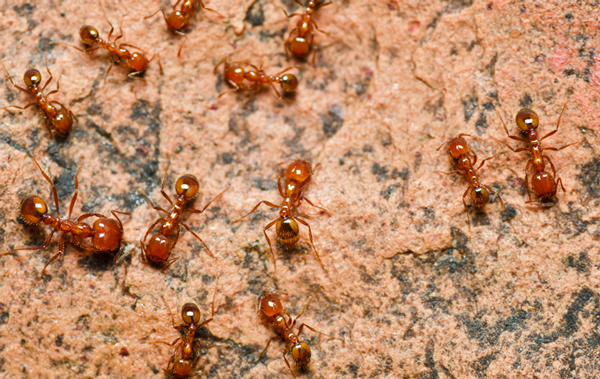More About Fire Ants
By Chris Williams on January 20, 2014.

Yes, I know we don’t have the ‘real’ fire ant here in New England. It is simply too cold for this South American invader, red imported fire ant to survive up here, but this invasive species has had a huge economic impact through out much of the south since it’s introduction during the 1930s’.
First accidentally imported into Mobile Alabama around 1930 this ant has spread to infest more than 260 million acres of land in nine southeastern states including Florida, Georgia, South Carolina, Tennessee, Alabama, Mississippi, Arkansas, Texas and Oklahoma. (Lofgren 1986, Sparks 1995) Red imported fire ant colonies make fairly large mounds in turfgrass which are unsightly and often create issues for golf course greens keepers by interfering with mowing or other field operations. In addition to golf courses, they can be found in residential lawns, parks, playgrounds or virtually anywhere turfgrass is growing. Red imported fire ant also can cause damage to motors, pumps, electrical boxes, transformers etc. and undermine pavement with their activity. The ants often invade homes aggressively defend their territory and will attack people, domestic animals, and livestock. Their stings can be life threatening for those people with severe allergies to them and they’re a threat to many native species of wildlife (ground nesting birds, reptile, mammals, etc) and even native ant species too!
All totaled, the annual costs for control efforts and damage caused by these ants exceeds three billion dollars! That is no small amount of ‘change’! Most of the control efforts have focused on chemical controls either by direct treatment of the nests or by the use of baits. These have had limited success but a new weapon has emerged in the past several years that is literally driving the red imported fire ant insane! Researchers at Texas A&M found an unusual species of parasitic phorid fly (actually several) native to Brazil and Argentina and successfully introduced it to control red imported fire ant starting back in 1999. One species of this tiny parasitic fly Pseudacteon tricuspis lays an egg on a worker fire ant and after this egg hatches the young larva burrows into the head capsule of the ant. Over a period of time as the larva develops the ant’s behavior changes from being focused and workmanlike to aimlessly wandering about. Why? Its brain is being devoured! The piece de resistance of the flies lifecycle is when the ant’s head falls off allowing the fully developed adult flies to emerge and then start the cycle all over again. The programmed release of these flies has been quite successful in the years since the initiative began.
By the year 2006, the little flies have been found attacking fire ants in nineteen different counties spanning 5 million acres in parts of Texas. To be sure there have been some setbacks as the flies have not performed equally well in all areas where they’ve been released, but they are having an impact. I don’t know about you, but I think that is pretty cool!
Further Reading
Some additional links used for reference are as follows:
- http://www.sciencedaily.com/releases/2006/09/060927110742.htm
- http://abcnews.go.com/Technology/AmazingAnimals/story?id=75926
- http://agspsrv34.agric.wa.gov.au/ento/fire_ants.htm